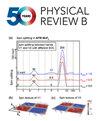Statistical phase evaluation approach for defect phase diagrams
IF 3.7
2区 物理与天体物理
Q1 Physics and Astronomy
引用次数: 0
Abstract
We propose an analytical thermodynamic model for describing defect phase transformations, which we term the statistical phase evaluation approach (SPEA). The SPEA model assumes a Boltzmann distribution of finite-size phase fractions and calculates their statistical average. To benchmark the performance of the model, we apply it to construct binary surface phase diagrams of metal alloys. Two alloy systems are considered: a Mg surface with Ca substitutions and a Ni surface with Nb substitutions. To construct a firm basis against which the performance of the analytical model can be leveled, we first perform Monte Carlo (MC) simulations coupled with cluster expansion of a density functional theory dataset. We then demonstrate that the SPEA model reproduces the MC results accurately. Specifically, it correctly predicts the surface order-disorder transitions as well as the coexistence of the 1/3 ordered phase and the disordered phase. Finally, we compare the SPEA method to the sublattice model commonly used in the CALPHAD approach to describe ordered and random solution phases and their transitions. The proposed SPEA model provides a highly efficient approach for modeling defect phase transformations.缺陷阶段图的统计阶段评估方法
我们提出了一种描述缺陷相变的分析热力学模型,我们称之为统计相位评估方法(SPEA)。SPEA模型假设有限尺寸相分数的玻尔兹曼分布,并计算其统计平均值。为了测试该模型的性能,我们将其应用于构建金属合金的二元表面相图。考虑了两种合金体系:Ca取代的Mg表面和Nb取代的Ni表面。为了构建一个坚实的基础,使分析模型的性能可以达到水平,我们首先执行蒙特卡罗(MC)模拟,并结合密度泛函理论数据集的聚类扩展。然后,我们证明了SPEA模型准确地再现了MC结果。具体地说,它正确地预测了表面有序-无序转变以及1/3有序相和无序相的共存。最后,我们将SPEA方法与CALPHAD方法中常用的子晶格模型进行了比较,以描述有序和随机的解相及其转换。提出的SPEA模型为缺陷相变的建模提供了一种高效的方法。2025年由美国物理学会出版
本文章由计算机程序翻译,如有差异,请以英文原文为准。
求助全文
约1分钟内获得全文
求助全文
来源期刊

Physical Review B
物理-物理:凝聚态物理
CiteScore
6.70
自引率
32.40%
发文量
0
审稿时长
3.0 months
期刊介绍:
Physical Review B (PRB) is the world’s largest dedicated physics journal, publishing approximately 100 new, high-quality papers each week. The most highly cited journal in condensed matter physics, PRB provides outstanding depth and breadth of coverage, combined with unrivaled context and background for ongoing research by scientists worldwide.
PRB covers the full range of condensed matter, materials physics, and related subfields, including:
-Structure and phase transitions
-Ferroelectrics and multiferroics
-Disordered systems and alloys
-Magnetism
-Superconductivity
-Electronic structure, photonics, and metamaterials
-Semiconductors and mesoscopic systems
-Surfaces, nanoscience, and two-dimensional materials
-Topological states of matter
 求助内容:
求助内容: 应助结果提醒方式:
应助结果提醒方式:


